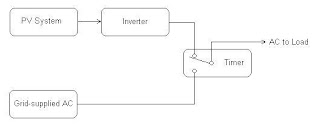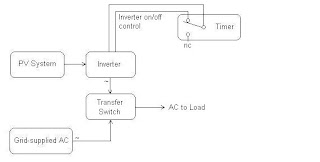Strategy #1
A 100-watt solar panel might produce 500-watt/hours of electricity on a sunny day. But, due to system inefficiencies, it’s likely that only about 300-watt/hours of energy will make it to the load. Using solar-generated energy during peak sunlight hours is one way to improve efficiency. When power from the solar panels goes straight to the inverter, overall efficiency is much greater, since the losses associated with storing and retrieving electrical energy in batteries are eliminated.
The AC load can be plugged into the PV system’s inverter during the day and then to grid-supplied power at night, or switched automatically via a timer as illustrated below. A refrigerator or freezer is an ideal load for this scenario, since the amount of electricity required is about the same from day-to-day. The timer can be adjusted to match the power generated by the PV system to the power required by the load.

Strategy #2
A no-cost way to squeeze every available electron from an off-grid system is to constantly monitor battery voltage, disconnecting the load when the battery falls to a certain level, and reconnecting it when the battery is once again fully charged. Obviously, monitoring the system 24 hours a day is not practical. However, most DC to AC inverters include a low-battery “alarm” feature. The alarm sounds when the battery voltage drops below a certain level, eliminating the need for constant monitoring. Still, listening for an alarm is only a modest improvement over constant monitoring. No one wants to respond to an alarm in the middle of the night. Another drawback of this strategy is that the low-voltage alarm level is usually not adjustable. Typically, the alarm threshold voltage is about 10.6 volts (for a 12-volt inverter), which, depending upon battery type, translates to about a 75% depth of discharge. Most inverters will shut-down when battery voltage falls a little below the alarm threshold. While this strategy will work to a certain extent, you shouldn’t allow your battery state of charge (SOC) to fall that low. Allowing battery voltage to drop to those depths on a frequent basis will shorten the life of the battery. This strategy is not recommended on a day-to-day basis, but could be used in emergency situations, such as a grid power failure.
Strategy #3
To automate the process of disconnecting and reconnecting the load based on battery voltage, a charge controller with built-in low voltage disconnect (LVD) capabilities can be used. An LVD-capable charge controller is a great strategy for unattended systems, such as a weekend cottage. If a load is accidentally left on, the battery will be protected.
Although this is a good solution for applications where power to the load flows through the charge controller, it is not viable in systems where power to the load does not. The input current of an inverter is usually higher that the charge controller can handle, making it necessary to connect the inverter directly to the battery.
The diagram below shows typical wiring for a small, off-grid, PV system. Notice that the inverter is connected directly to the battery, and therefore will not be shut down when the Charge Controller’s low voltage disconnect kicks in. Only the DC output from the Charge Controller will be shut down in this scenario. Battery voltage will continue to decline (because of the AC load), even after the Low Voltage Disconnect kicks in. At some point the inverter will stop functioning. This is not a good strategy unless you’re only using the DC output of the Charge Controller to power a load, or unless you’re carefully monitoring the battery voltage while powering an AC load.

Strategy #4
Some Charge Controllers can be configured as “Load Controllers”, providing another strategy for getting the most from a small system. A Load Controller does not replace a Charge Controller, it is an add-on to the system. An advantage of using a Load Controller is that disconnect and reconnect thresholds can be precisely set. Settings are determined by the type of batteries, and by the size of the load. When properly set, the disconnect set-point prevents the battery from discharging too much, and the reconnect set-point value is high enough to ensure that the battery is not damaged by chronic undercharging. In other words, the disconnect and reconnect settings are optimized. The extra hardware does, of course, add considerable cost to the system.
Shown below is a typical application of a Load Controller. In the example, the Load Controller uses the batteries as the primary source of energy, but switches to a secondary source of energy when the batteries are depleted to a preset level. Once the batteries are recharged, they are again used to power the load. The beauty of this system is that it uses as much “free” energy from the sun as is available, only using a more costly source of energy when necessary.

Strategy #5
Those with electronics skills may consider the solution outlined below. This diagram represents a simple circuit that can replace the “Load Controller” and relay in the diagram above. Disconnect and reconnect voltage levels are set via two potentiometers. The potentiometers could be replaced by thumbwheel switches and precision resistors, providing better control of the threshold voltages. Notice that the relay wiring doesn’t allow AC from the inverter and AC from the power grid to be applied to the load simultaneously. Allowing that to happen would probably result in damage to the inverter.

Strategy #6
The battery-protecting switchover functions described above are also available in equipment designed for larger systems, but that equipment may not be appropriate for small systems. In addition to the high cost, this equipment typically uses more power for its operation than equipment designed for smaller systems. While this power drain may not be significant for a large system, it represents a significant percentage of the overall energy production of a small system.
Conclusion
In compiling this information it has been my intention to demonstrate optimization while holding down the cost. You may benefit from using one or more of the strategies outlined here. I welcome other suggestions for accomplishing the task.
John
 The circuit above will work, but for safety and NEC code compliance a transfer switch should be used. The inverter can be switched on and off via a timer as shown below:
The circuit above will work, but for safety and NEC code compliance a transfer switch should be used. The inverter can be switched on and off via a timer as shown below: The transfer switch can be wired so that it selects the inverter when AC is present, and switches to grid-supplied power when necessary. The timer can be programmed to switch the inverter on during the day, and off at night.
The transfer switch can be wired so that it selects the inverter when AC is present, and switches to grid-supplied power when necessary. The timer can be programmed to switch the inverter on during the day, and off at night.




























